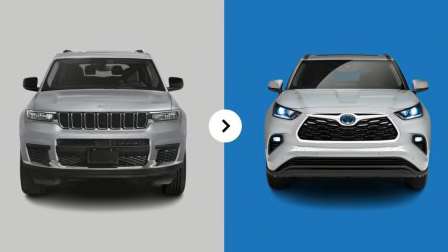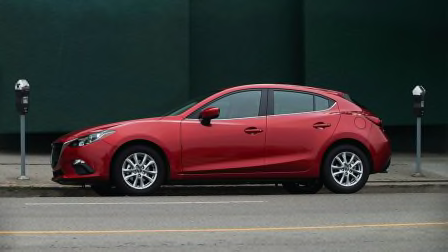How to Choose a Fuel-Efficient New Car
Get maximum fuel economy, no matter what type of vehicle you plan to buy

Safety, fuel economy, and reliability are always on the list of car buyers’ top concerns. But with regular gasoline averaging $3.92 a gallon nationwide as of Oct. 10. 2022—that 65 cents more than a year ago—fuel economy may be bumping to the top of the list for a lot of motorists. Fortunately, there are ways to improve fuel economy with the vehicle you own. But if you’re shopping, you may find major gains are possible, especially if you move to a hybrid of the same class, or a smaller vehicle, or if you join the electric car revolution.
“Good fuel economy” is relative; there are models in every category that deliver more efficiency than the norm, from hybrid SUVs to diesel pickup trucks. But such technology isn’t the only news in fuel savings.
Conventional gasoline-powered cars are more efficient than ever and are squeezing more miles out of every gallon of gas, thanks to advances in engine technology, better aerodynamics, and clever computer controls. Replacing the typical used car, being 5 or more years old, with a similar model can see significant fuel-economy gains. But you can do better with just a bit of research.
Exploring the Possible Savings
The typical person drives about 12,000 miles each year and now pays $3.92 for a gallon of regular gasoline. Let’s look at a scenario to underscore the value of exploring your options:
• Say you have a 5-year-old minivan. Moving from a 2017 Honda Odyssey (21 mpg overall) to a 2022 Odyssey (22 mpg) would save $102 a year in gas.
• A similar upgrade from a 2017 Kia Sedona (20 mpg) to a 2022 Kia Carnival (21 mpg) would save $112 a year at current prices.
• However, the redesigned Toyota Sienna comes standard with a hybrid powertrain, and it returned a stunning 36 mpg overall in CR’s tests. Trading in that Odyssey or Sedona for a new Sienna could save $933 and $1,045, respectively, a year in fuel. And that is just one of many examples available across the automotive spectrum, thanks to the proliferation of hybrids.
Split the Difference With a Plug-In Hybrid
Plug-in hybrid-electric vehicles bridge the gap between a hybrid car and an electric vehicle: They can run on electric power for longer and more often than regular hybrids, which have limited electric-only capabilities. Once their electric-only mode is depleted, they revert to regular hybrid operation. Their relatively small batteries, compared with an EV’s, provide 22 to 45 miles of electric-only driving—enough for local errands and short commutes. Most of them also qualify for a federal tax incentive of up to $7,500.
Note that when the gasoline engine is operating, these are less efficient than a true hybrid because of the extra battery weight. However, the combined results, especially for drivers who can charge frequently and take short trips, PHEVs can yield very impressive fuel economy. For example, the Prius Prime plug-in returns 50 mpg in hybrid mode, compared with 52 mpg for the regular Prius. However, it can provide more than 20 miles of electric-only power, making its equivalent fuel economy, at least for that first gallon, more like 70 mpg.
And while most EV owners will want to install a dedicated wall-mounted, 240-volt charging station, plug-in hybrids handily recharge overnight using a regular 120-volt outlet.
Ready to Go Electric?
The best way to save on gas is to not use it at all. There is an increasing array of electric vehicle choices, with many more expected over the next year. Already there are small hatchbacks, like the Chevrolet Bolt and Nissan Leaf, and premium models like the Mercedes-Benz EQS, Porsche Taycan, and Tesla Model S. In between, there is a growing crop of EVs like the Hyundai Ioniq 5 and Kia EV6 that joined the Ford Mustang Mach-E, Volkswagen ID.4, and Tesla Model 3 and Model Y, with fresh entries, such as the Subaru Solterra and Toyota bZ4X coming later this year.
EVs can be very appealing if you have a convenient place to charge overnight. The range for most models is well over 200 miles—more than enough to cover the daily use for most drivers, with ample miles for weekend adventures. A growing public charging network can provide comfort for longer trips.
Using electricity, rather than gas, to propel the car cuts the cost of driving by 50 to 75 percent at today’s gas prices. Of course, electricity costs vary by state. Costs are further impacted by whether you’re able to home charge during off-peak hours at a lower rate, or if you use public DC fast chargers, which cost more per kilowatt-hour to use.
A 2020 CR study showed that there are significant potential savings in maintenance because of the simpler powertrain. Even though EV owners don’t have oil changes to deal with, several other common wear items, like wipers, brakes, and tires, will still need periodic service.
CR reliability surveys show that some EVs have reliability concerns. But rather than being an inherent issue with EVs, our analysis showed that initial teething pains with some models stems from them being truly all-new designs with lots of technologies, but not the EV components. We see a similar phenomenon with regular cars: Models that are complete, ground-up designs with new platforms, powertrains, and in-car electronics tend to have more problems than those that are partial redesigns, say using an engine or infotainment system that had launched previously on another model. In either case, it is smart to wait a year or two for any all-new design to allow for manufacturing gremlins to be sorted out.
Given the commitment automakers have announced, there will be tremendous focus on EVs later this decade, particularly in California, where regulations are pushing consumers to adopt electric cars. Even if an EV isn’t right for you now, there’s a good chance one will be in your driveway eventually.
But What About Diesel?
Diesel passenger cars have faded away from the American market. Several pickup truck and SUV models are available, however. While they are cleaner than they used to be, diesels don’t have the same low emissions as hybrids and the price of diesel fuel is higher than that of regular gas—$5.06 as of Oct. 10, 2022.
Bottom Line
There have been money-saving improvements in fuel economy over the past few years, meaning drivers trading in models—especially those that are at least 5 years old—would have no problem identifying a replacement with better fuel economy. The real win is if you can make a significant gain, perhaps by choosing a hybrid, while also getting a car with the latest safety features and a strong track record for reliability. This is very feasible if you do your homework. Consumer Reports ratings can help, and our Top Picks can be a great place to start.
Shopping for an EV or a Hybrid?
See our EV/hybrid ratings and buying guide. And read "Without a Gas Tax, How Will EVs Be Charged for Road Use?"




















